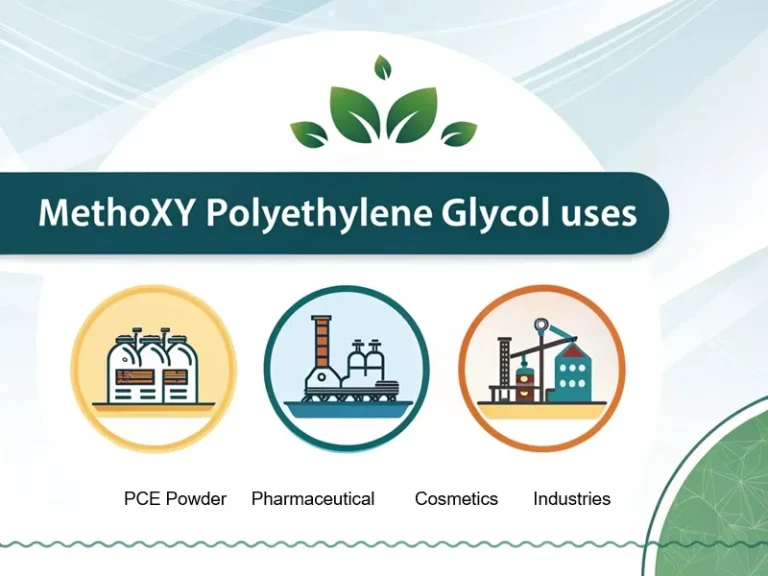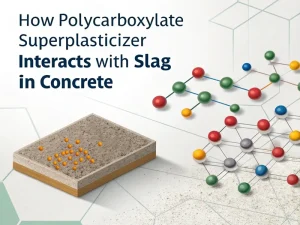Blog

Methoxy polyethylene glycol (MPEG) is a single methoxy-terminated polyethylene glycol derivative with a molecular formula of CH3O(CH2CH2O)nH, n=10-120. It is generally prepared by reacting methanol and ethylene oxide in an appropriate catalyst.
Thanks to its excellent water solubility, physiological inertness, and chemical properties, MPEG has become a core material in fields such as medicine, biotechnology, and materials science. This article will delve into its key application scenarios and the scientific principles behind them.
Methoxy polyethylene glycol (MPEG) plays a crucial role in the synthesis of polycarboxylate superplasticizer (PCE), a high-performance concrete admixture. By reacting MPEG with acrylic acid (or other monomers containing polymerizable double bonds, such as methacrylic acid), ester derivatives such as MPEG acrylate (MPEG-A) or MPEG methacrylate (MPEG MA) are formed. This esterification reaction introduces reactive double bonds (-C=C-) into the MPEG structure, enabling it to participate in free radical polymerization reactions and form polycarboxylate chains.
Methoxy polyethylene glycol polycarboxylate superplasticizer has the following performance characteristics:
High water reduction rate: It can significantly reduce the cement content of concrete and improve its fluidity.
Good slump retention: It can effectively prolong the slump retention time of concrete and reduce the loss of concrete over time during construction.
Moderate air intake: capable of introducing bubbles in moderation, improving the workability and durability of concrete.
Low bleeding: Reduce the bleeding phenomenon of concrete during pouring and improve the uniformity and compactness of concrete.
These performance characteristics make methoxy polyethylene glycol polycarboxylate superplasticizer widely applicable in high-performance concrete construction, which can significantly improve the quality and construction efficiency of concrete.
One of the most prominent uses of MPEG is drug delivery. MPEG is often used as a coating or modifier for drug molecules, nanoparticles, and other therapeutic agents. It can improve the stability of drugs and protect them from degradation in harsh physical environments. This is particularly important for drugs that are prone to chemical or enzymatic degradation.
In addition, MPEG can enhance the solubility of hydrophobic drugs. Many potent drugs have poor water solubility, which limits their effectiveness as they cannot dissolve normally in the bloodstream. The hydrophilicity of MPEG enables it to form a shell around these drugs, allowing them to dissolve in aqueous solutions. This solubilization effect is commonly used to create nanoscale micelles or vesicles that can encapsulate hydrophobic drugs and facilitate their delivery to target sites in the body.
MPEG is also widely used in the PEGylation process, where it attaches to drug proteins and enzymes. The MPEG coating acts as a protective cover to prevent protein and enzyme degradation. It can also reduce their immunogenicity, making them less likely to be recognized by the immune system as foreign objects and trigger an immune response.
Coating MPEG on the surface of medical devices minimizes protein adhesion and bacterial growth on implants, catheters, and other medical device surfaces. When medical devices are implanted into the body, the first reaction is the adsorption of proteins from surrounding tissues to their surface. This protein adsorption can lead to inflammation, immune response, and bacterial biofilm formation. By coating MPEG on the device, these unnecessary interactions can be reduced.
The smooth hydrophilic surface generated by MPEG repels proteins and bacteria, preventing them from attaching. This not only improves the biocompatibility of the device, reduces the risk of adverse reactions for patients, but also extends the lifespan and functionality of medical equipment.
Products with different molecular weight fractions can be selected to change the viscosity, moisture absorption, and tissue structure of the product. The products with low relative molecular weight (molecular weight less than 2000) are suitable for use as wetting agents and consistency regulators, such as cream, lotion, toothpaste and shaving cream. Products with high relative molecular weight are suitable for lipstick, deodorant sticks, soap, shaving soap, foundation make-up, beauty cosmetics, etc.
MPEG is an effective moisturizer in many lotions and face creams. The hydrophilicity of MPEG enables it to attract and retain water molecules, keeping the skin hydrated. This is particularly beneficial for people with dry skin, as products containing MPEG can help maintain skin moisture balance and prevent dryness, peeling, and roughness.
MPEG is also a solubilizer in cosmetic formulations. It can help dissolve various ingredients that would otherwise be difficult to incorporate into water-based products. This enables the creation of more complex and effective cosmetic formulas. For example, some active ingredients or essential oils may have poor solubility in water. Still, with the help of MPEG, they can be evenly dispersed in the product, ensuring that they are delivered correctly to the skin.
MPEG can also be used as an emulsifying agent in soap manufacturing and other cosmetics. In lotion, such as lotion and cream, it helps to stabilize the mixture of oil and water phases. By reducing the surface tension between two immiscible phases, MPEG allows for the formation of a small and uniform droplet dispersed in another phase, resulting in a stable and uniform product.
In the textile industry, MPEG has various applications. It can be used as a spinning aid to help reduce friction during the spinning process. This leads to smoother yarn production and fewer defects in textile fibres. MPEG can also be used as a component of sizing agents to coat the surface of textile fibres. The sizing agent containing MPEG provides protection for fibres during weaving and other textile manufacturing processes, reduces breakage, and improves the overall quality of the fabric.
In addition, MPEG can act as a solvent and dispersant in dyeing operations. It helps to evenly disperse dyes in the dye bath, ensuring uniform colouring of textile materials
In summary, methoxy polyethylene glycol is a widely used compound with a wide range of applications in the pharmaceutical, cosmetic, textile, adhesive, coating, and chemical synthesis industries. Its unique properties, such as biocompatibility, solubility, and the ability to alter surface properties, make it an important component in many products and processes. As research continues, new applications of MPEG may be discovered, further expanding its utility and impact in various fields.

How Polycarboxylate Polyether Monomer Affect Concrete Performance
Blog How Polycarboxylate

How Polycarboxylate Superplasticizer Interacts With Slag In Concrete
Blog How Polycarboxylate